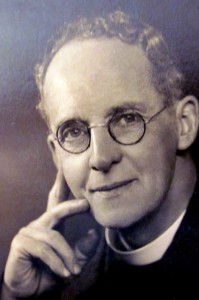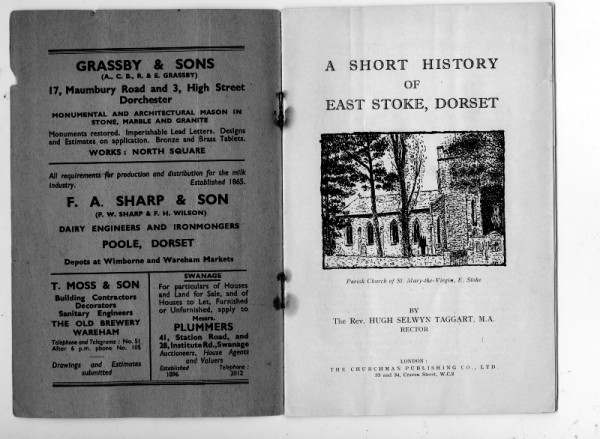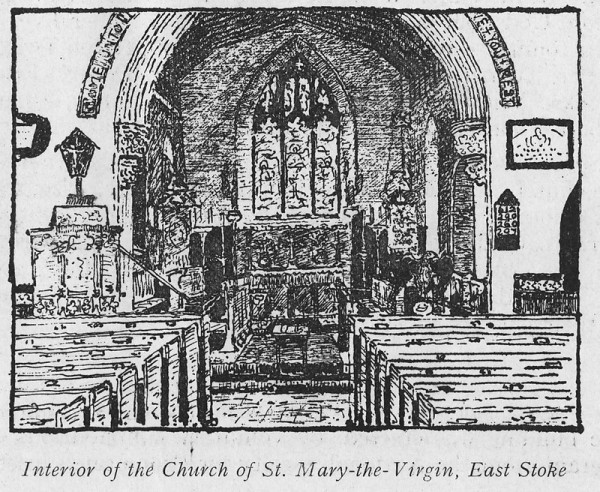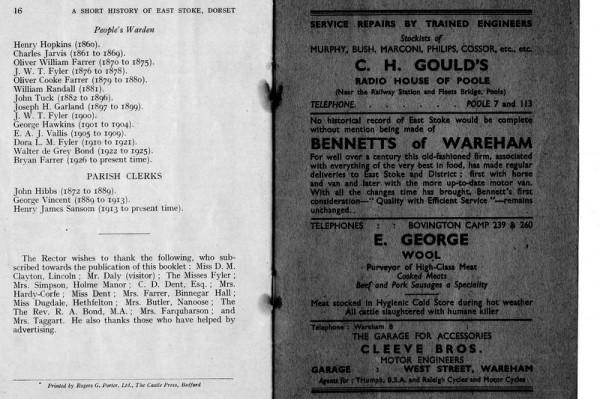I don’t have a roof-space; mine is a small single-storey cottage with beams – not even old ones – but my living room is pretty much like anyone else’s can’t-find-a-thing-for-dust-and-boxes attic.
 Yesterday, whatever I was searching for in one of these boxes was pushed out of my head when I found a small forgotten treasure: a booklet, A Short Historyof East Stoke, Dorset, by The Rev. Hugh Selwyn Taggart – my gorgeous granddad!
Yesterday, whatever I was searching for in one of these boxes was pushed out of my head when I found a small forgotten treasure: a booklet, A Short Historyof East Stoke, Dorset, by The Rev. Hugh Selwyn Taggart – my gorgeous granddad!
He wrote it while he was Rector of Saint Mary-the-Virgin in East Stoke, England, probably in 1939 as that would have been the centenary of the ‘new’ church building (the original church dating from at least 1306). On the cover is written ‘With the author’s compliments’; it hadn’t been addressed to me, I wasn’t even a twinkle in anyone’s eye then so it must have been sent to me by my aunt at some time in the distant past.
Why he took up the living in Dorset in 1936 , or how long he stayed there, I don’t know; he was a Manxman and, like his father before him, was ‘Parson Taggart’ of St Matthews Church in Douglas for most of his career. It was in the Isle of Man as a child that I knew him. Visiting him was a huge treat. Retired by then and becoming frail, he would beckon me nearer, his eyes shining with smiles, and talk in his soft confiding voice as if I was the only person in the world he could possibly share his thoughts with. And now he’s quietly re-appeared in New Zealand from a box under the bed.
 I turned the booklet over to the advertisements on the back: ‘George Dicker, Grocer, Wareham. Telephone: Wareham 11’. That telephone number says so much. Is Dicker’s still there?
I turned the booklet over to the advertisements on the back: ‘George Dicker, Grocer, Wareham. Telephone: Wareham 11’. That telephone number says so much. Is Dicker’s still there?
The booklet begins: “The name of our Parish is derived from the Saxon word “stoke,” which meant a village. In the reign of William l its over-lord was the Earl of Mortain (or Moreton). Before the Conquest it belonged to a Saxon named Edmer and had a mill worth 50s. This is undoubtedly the Mill which still stands, though it no longer grinds.”

A later section gives a potted history of several ancient ‘big houses’ of the area, including Hethfelton (Hafelton in the Doomsday Book); Stockford and, of course, Woolbridge, famous for its part in Thomas Hardy’s Tess of the d’Urbervilles. Originally belonging to the Abbey of Bindon, Woolbridge came into ownership of the Turberville family in the reign of Elizabeth l. The last Turbervilles were twin sisters who lived all their lives together and died in the same house (in Fulham) in the same year at the age of 77 years. “The portraits of the two Turberville ladies, whose features caused Tess in Hardy’s novel to shudder, are still to be seen on the walls of the first-floor landing.”
 Granddad used his own detailed sketches in describing the ruins of the old church and the ‘new’ building as it was in his time. I can imagine that sitting in one of the pews and sketching his own church gave him particular delight: it was not his usual view from in front of the altar or in the pulpit.
Granddad used his own detailed sketches in describing the ruins of the old church and the ‘new’ building as it was in his time. I can imagine that sitting in one of the pews and sketching his own church gave him particular delight: it was not his usual view from in front of the altar or in the pulpit.
Of special interest to him, though, would have been the Parochial Records: he always took a practical interest in the physical as well as spiritual wellbeing of his flock – to the annoyance of my grandmother it was not unusual for him to give away his clothes or even his dinner if a needy person knocked at the vicarage door. In the early 1800s, in the absence of a welfare state or of union benefit societies, the poor were assisted by officials of the Parish using funds collected by local levy. A few of the many examples in the booklet are given below:
 There was another problem in the Parish at this time, too. At a Vestry Meeting on 29th April 1802, it was decided to pay the following bounties for the killing of vermin within the Parish of East Stooke [sic] : 2 shillings a dozen for rat’s heads; 2 pence per dozen for sparrow’s heads, and 4 pence for each and every hedgehog’s head.
There was another problem in the Parish at this time, too. At a Vestry Meeting on 29th April 1802, it was decided to pay the following bounties for the killing of vermin within the Parish of East Stooke [sic] : 2 shillings a dozen for rat’s heads; 2 pence per dozen for sparrow’s heads, and 4 pence for each and every hedgehog’s head.
(It may be some comfort to know that no payment for hedgehog’s heads is recorded).
As a final extract, here are the lists of Rectors from 1306, and of People’s Wardens which were listed only from 1860. If you are from the area you might know some of these names: one of them might be your granddad or great-granddad.


Regrettably I was born too late to hear Granddad preach at St. Matthews in the Isle of Man, but my Aunt (Betty Taggart) – who dedicated her life to teaching infants and looking after both her aging parents – once told me that when Granddad offered sung evensong, the church was so full people stood in the aisles right back into the porch. I suspect most of the ladies of the parish were secretly in love with him.
I was only 9 years old when Granddad died at the age of 92; I couldn’t expect him to wait for me much longer but I feel an unreasonable sadness that I wasn’t born a few years earlier, or Granddad born later.
If you still have grandparents, go and talk with them; if not, try ferreting around in the attic – you never know what treasure you might find.
If you are writing memoir, biography, family or local history, you might find Writing Your Nonfiction Book: the complete guide to becoming an author, useful, because it has sections specific to these genres.

Thank you for sharing your Granddad with us Trisha, and this wonderful little book. What a remarkable man. I can feel his warmth and your love for him. coming off the screen.
Warmest
Rob
That’s a lovely comment to make,Rob, thank you so much. I really enjoyed writing it and delving into the family photo album as well, although that picture of him is in my living room along with my other granddad – another blog some other time. Trish
That was a lovely blog. Thanks for sharing it with us.
Thank you for stopping to read it, so glad you enjoyed it.
Rarely do I comment on other writers’ websites but this was such a lovely piece I just had to say how much I enjoyed reading it. I too have found some fascinating history amongst my late father-in-laws private correspondence. Like you, I will treasure this for the rest of my days. Thanks for sharing, Trisha.
Mari
Hello Mari, I’m delighted this piece brought a rare comment from you. And it’s amusing to think what Granddad would have thought of all this, I think he would have chuckled at the size of his virtual congregation. Thank you for commenting.
Hi, Trish,
What a lovely heart warming story. Dorset is a lovely place, I wish I could help with your research, but I have only a passing knowledge of the area. By coincidence we were staying in Dorset with a friend last weekend and did visit Dorchester (not far from East Stoke – a shame I didn’t know earlier), and, best of all, a place that has got under my skin like no other for reasons I can’t completely explain: Athelhampton House.
Good luck with your search.
Sincerely
Oscar xx
Hello Oscar, lovely to have your comment. For me it’s not so much a serious search as the pleasure of making some connection with Granddad’s time there – I’m intrigued as to why he was there. That area will certainly be on my visiting list next time I’m in the UK. What a coincidence for you to be in Dorchester last weekend. I love those sorts of connections on the web. All the best to you, Trish xx
It’s so interesting to read this historical treasure when I too am in the midst of historical reconstruction. American history is very short compared to UK history, but I nevertheless am the eleventh generation of Swiss-German Mennonite descent in the U.S. and have to work to uncover my roots. Right now I am reading my mother’s wartime diary alongside Anne Frank’s. They were about the same age, writing at the same time.
Oh, I love the idea of an adult treehouse. Such a great idea beautifully executed!
What an interesting project, covering two continents at least. I can’t claim to be working on historical reconstruction, it just seemed a fun idea to connect with someone from Granddad’s life. You are fortunate to have your mother’s diary, what a treasure. I wish you every success in your research. So glad you like the treehouse – visit any time!
Hi Trish
I really enjoyed your story. Amazing what treasures one can find in a box. Sounds like your Grandad was hot 😉
I live in Poole but unfortunately am unable to help with your research. However, I have retweeted your tweet on Twitter as I have a few local followers… you never know.
All the best
Sarah
Thank you so much Sarah. It’s all a long time ago now of course. I just thought it might be fun if someone popped up and said “yes, Dickers is still here”, or “the last church warden on that list is my great uncle”. Next time I manage to get to the UK I shall certainly visit East Stoke. Thank you for commenting, all the best to you too. Trish
Hi trisha,
I live at east Stoke, and was trying to research who originally owned a piece of land left to the village. Read your blog and thought I would reply.
Unfortunately the new church is now a house, the school is now a house and the original church is in ruins.
Any questions please feel free to ask.
P.s it’s still a lovely village to live in.
Adrian
Hi Adrian. Great to hear from you. From what you say about the changes there it is hardly surprising no-on else has responded. Thank you for getting in touch, I will email you. Trish.